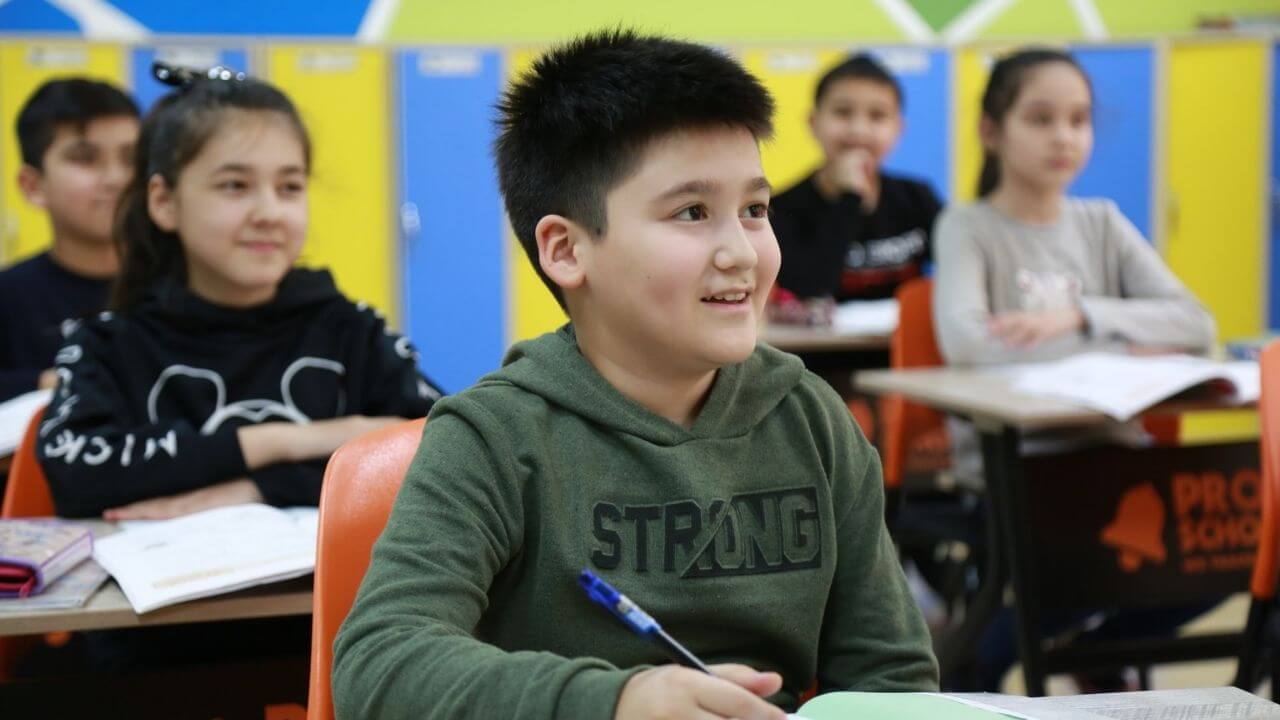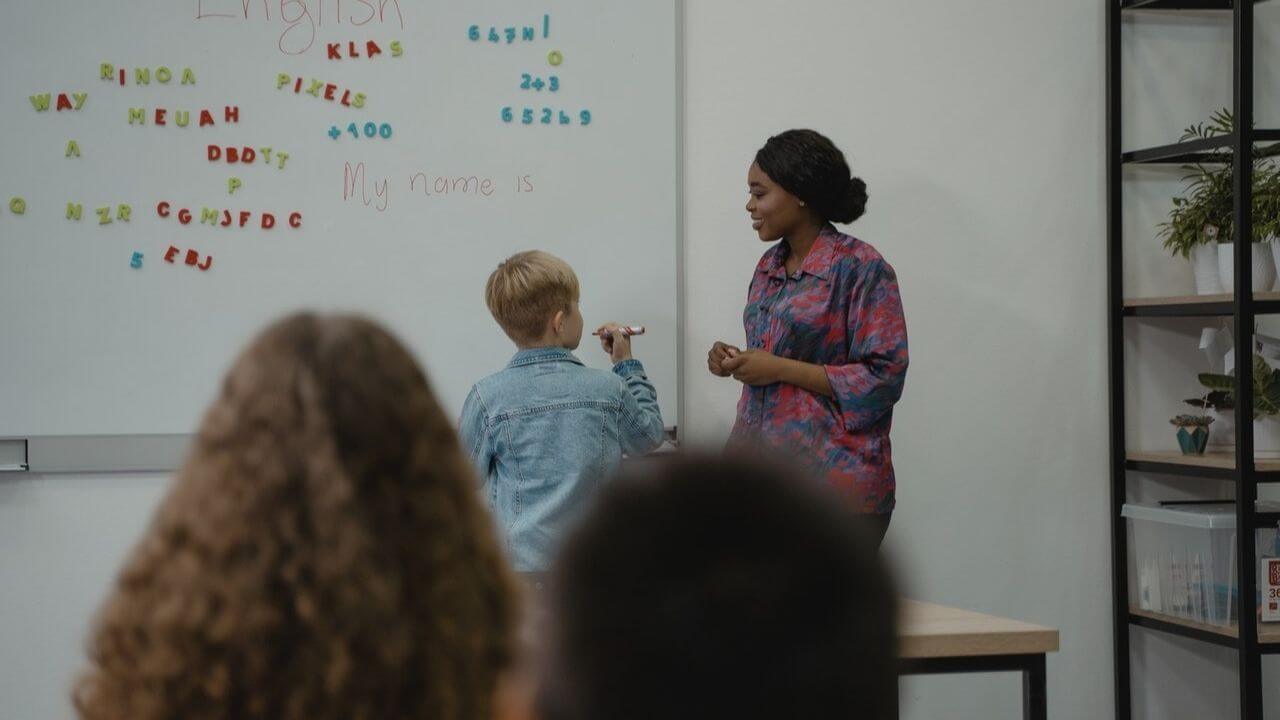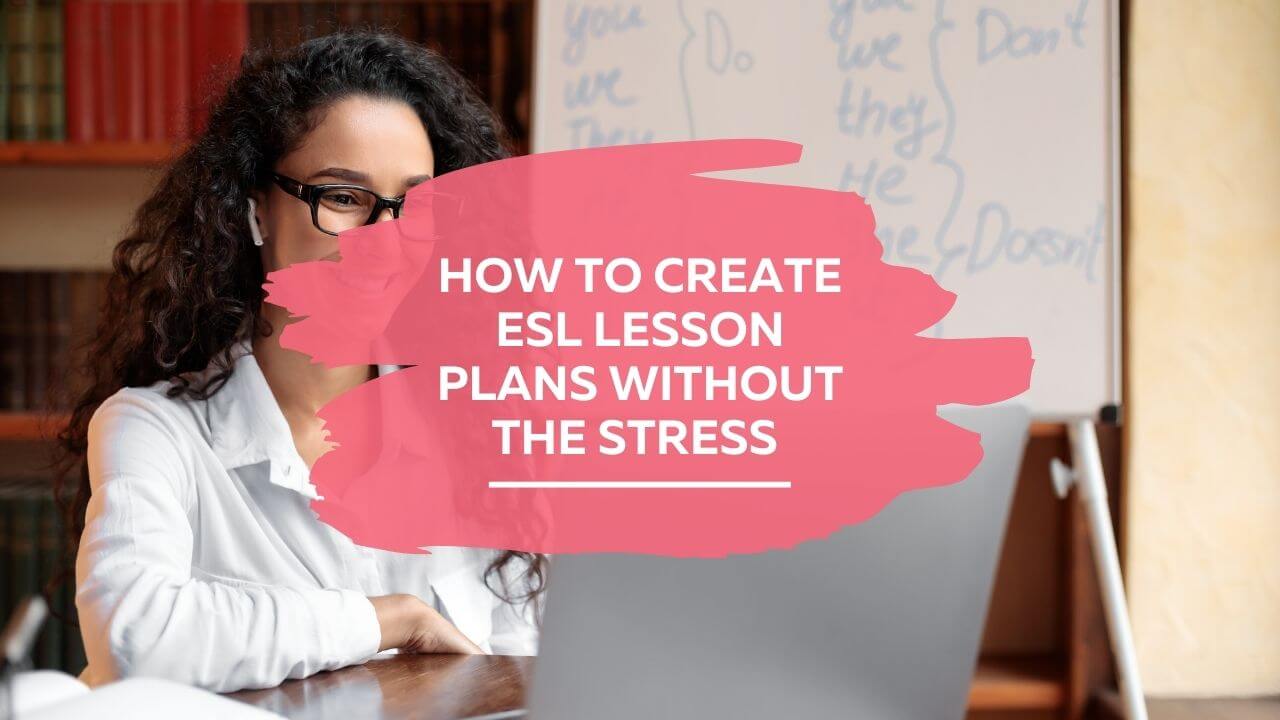So, you’re an ESL teacher or thinking of becoming one and you’re wondering how to create ESL lesson plans. No wonder. A big part of any teacher’s work happens behind the scenes, whether that’s lesson planning or grading work.
But the danger is that you spend too much time planning and running around trying to find resources. In this post, you’ll learn how to and why to plan for different kinds of ESL teaching contexts.
Plus you’ll discover some ways to not over-plan while keeping the lessons relevant to your students and bringing the best of yourself to class. No one wants an exhausted teacher who spends all their evenings planning!
So if you want to learn how to create ESL lesson plans without the stress, this is the post for you.
Pro Tip
If you want to become a qualified online language teacher and earn a living from home, I recommend checking out CeOLT (Certificate of Online Language Teaching).
Why Create An ESL Lesson Plan, Why Not Just Wing It?

If you’ve never taught before, you might assume that an experienced teacher is doing what comes naturally to them. They make it look easy so you assume they haven’t had to plan what they’re doing.
But if you go into a lesson without a plan, you’ll quickly understand why you need one. Believe me, when I was training to teach, I sat through a lesson given by a fellow student who hadn’t bothered planning.
His comedy improvisation skills made the students laugh for a bit. but it was excruciating to watch as he clearly hadn’t done any work before coming to the class.
It was funny. But it sucks for the students who rely to a certain extent on their teacher to be organised, choose interesting materials and break down the endless ocean of English learning into manageable chunks.
If you do a teaching certification like the CeOLT or CELTA, then during those intense weeks, you’ll be doing rather intricate planning for your teaching practice hours. Yes, they make you give real lessons in front of real students!
But, when you start working as an ESL teacher, you won’t have time to plan in minute detail like this. And you won’t need to either.
How To Create ESL Lesson Plans: How & What To Plan

So, you need to plan. But how much to plan, and what to plan is going to vary with who you're teaching and in which types of context.
Groups
If you’re teaching groups, especially in an offline setting, you’ll need to do more planning as well as more classroom management. You’ll need to plan periods of individual work as well as work in pairs and groups.
It can be a challenge to find the right balance of activities and pacing. Some of that will come down to experience. So your planning load will lighten as you spend more time giving lessons.
Kids

When I first started teaching kids, the school owner warned me that I would need to plan to change activities every five minutes! Every five minutes!
I had come from adult teaching so I knew you needed some variety in the lessons. But of course adults can concentrate for a bit longer than 5 minutes, thankfully.
If you’re teaching kids then, be prepared to have lots of activities up your sleeve. Think games, worksheets (if they’re old enough to read and write), props, realia (real objects), songs etc. And a lot of energy reserves, you’ll need it!
Teaching 1:1

When you teach 1:1, you still need to plan, but it can be a little less relevant than in the above scenarios. Sometimes, you might go into class with a plan. And then the student brings up a topical or personal issue. And you go down a rabbit hole, discussing that instead.
That’s why teachers who do a lot of 1:1 especially, are interested in teaching techniques like the dogme approach. This is a “materials light” approach where what happens in lessons depends on what students want to discuss, rather than what's in the textbook.
After experiencing emotional burnout herself, ESL teacher Maria Glazunova started experimenting with ways to cut down planning time by focusing more on her students and less on the material. She wrote about it in her book, How To Reduce Your Time Preparing for Online Classes and Prevent Emotional Burnout.
How To Create ESL Lesson Plans: Typical Stages Of An ESL Lesson

Here are some ground rules for planning a lesson. Bear in mind that this will vary depending on the aims of the lesson. Is this a grammar lesson? Are you working on speaking skills?
Also, lessons don’t exist in isolation. ESL students need a huge amount of recycling of vocabulary and grammar structures, especially if they don’t have much contact with English outside of class.
While you should encourage them to make contact with the language outside of class, especially if they’re independent adult learners, this may be trickier or less realistic if they’re teenagers at school.
That’s why it’s better to think of your lessons as an ongoing series, rather than a bunch of isolated classes. More on how to incorporate that into your planning in a second.
You might not incorporate all of these stages into your planning – it’s a general overview of a typical lesson.
Welcome
Asking the students how they are and welcoming them to class can go a long way to building goodwill.
You can also get a sense of how they’re doing – is everyone alert? Is there low or high energy today? This can help inform your next steps (and why it’s important to have back-up plans).
Review
Spend a little bit of time asking them to remind you what you worked on last time. A nice way to get everyone energised could be to play a quick game to revise vocabulary.
Warm-Up
Most lessons have a short warm-up phase to get the students interested in the lesson topic. And activate some existing language they might have for talking about it.
You could ask them questions, show them pictures or give them clues to guess what you’ll be discussing. The basic thing to know is – don’t jump in cold to the topic. But also don’t announce it off the bat. Warm them up, get them interested.
This might be a bit different to the “open your books on page 27” style of lesson you might have had at school!

Presentation
Now you’re getting into the meat of whatever it is you’re teaching, whether it’s new vocabulary, a grammar point or a text to read or listen to.
There are many ways to do this. In the StoryLearning® method for example, you learn grammar and vocabulary in context first, by reading a story.
Practice
This part usually involves filling out a worksheet or some other form of “controlled” practice. The students aren’t using the language freely, but rather, trying it out within the parameters of an exercise. They can do this alone or in groups or a mix of both.
Production
In this part of the lesson, students can use the language more spontaneously. They might discuss the topic in pairs, do a role-play, interview each other etc. This production could be written or spoken depending on the lesson focus.
Recap
Don’t leave them hanging or wait till the bell rings. Ask students to summarise what they worked on today, what they’ve learned and what they enjoyed.
How To Create ESL Lesson Plans: 3 Tips To Reduce Planning Time

Planning lessons, like correcting and grading work can be a real time suck for teachers. To make your life as easy as possible, as well as to make your lessons as good as they can be, you need to figure out how to reduce planning time.
That’s right, doing less work can help your students. Nobody wants a lesson from a frazzled teacher who’s been up till 3am planning. If you’re constantly trying to plan exciting new lessons, then you won’t have much bandwidth to respond to the students in class.
The golden rule is – you’re teaching humans, not the lesson plan!
So plan, but also plan to be flexible in case what you’ve prepared doesn’t work out for whatever reason. Always have a back-up plan (games, materials, worksheets etc up your sleeve in case you need to pivot).
And be prepared to go with the flow and with what your students want to talk about.
#1 Use Published ESL Material

Don’t reinvent the wheel – use material that’s already out there and that has been tried and tested. This doesn’t mean you can’t tweak or modify it, of course you can.
And besides, you always need to be ready to tweak what you’re doing if the lesson doesn’t go how you planned.
Here are some websites you can try out:
- Off 2 Class – a lesson plan library that works well for 1:1 teachers or anyone in an online teaching setting
- English Club – materials for both learners and teachers, many of which are free
- Using English – created by experienced teacher Alex Case, you’ll find materials, quizzes and a forum for both teachers and students
- Perfect English Grammar – created by my friend Seonaid way back in 2007, the site has interactive exercises and downloadable PDFs about every grammar topic imaginable
- Teachers Pay Teachers – exactly what it sounds like, teachers upload lesson plans that others can download for a fee
You can pay it forward by sharing your lesson plans too. In fact, teaching as a profession is made easier for everyone whenever teachers share lessons that have worked well for them. Don’t be that person who hoards all the good stuff for themselves.
Published ESL material can include textbooks and grammar books too! It could also mean using a book like my, short stories in English book. Check out the teacher’s guide which comes with ideas, lesson plans and worksheets.
And finally, don’t forget games – plenty of word games you already know can be adapted to the language classroom. While they won’t fill a whole lesson, playing a quick game of hangman can be a nice way to review vocabulary.
Create Recyclable Materials
Once you’ve road tested and improved on your own materials, keep using them! There’s nothing better for students than coming to a lesson where the teacher knows the material inside out and can focus more on the students than getting through the plan.
Me and a friend (another tip – plan with other teachers! ) once created a lesson plan based on the movie “The Spanish Apartment”. It was a hit with the students and an absolute hoot to deliver so definitely a lesson to keep in the archive!
Create A Recyclable ESL Lesson Format

Taking this logic one step further, why not create templates and formats for a series of lessons that you can use.
At one point, I was teaching English to students in a University humanities department. Their main degrees were in subjects like history, sociology, history of art, geography, theatre studies etc. But they had to also study a language as a minor option.
They weren’t English specialists and some of them weren’t super happy about having to do 2 hours of English a week. So we made the classes relevant to their interests and about the subjects they needed to discuss in English.
We created a booklet with material from their specialist subjects to last the semester. One week they would analyse a painting, and we would teach them the language to do that. Another week, they might discuss a historical figure, or analyse some geographical data.
This was also a sneaky way to teach/revise some grammar and vocabulary structures with them, without it looking like a traditional English lesson.
It’s essential for history students to know how to say dates in English for instance. And it’s more fun to practise them when talking about historical events than, say, reading aloud irrelevant dates in a textbook or on a worksheet.
All the material was in the booklet. This created more work upfront, but less during the semester, when work can get rather crazy. It also helped these students, many of whom were not confident about their English, feel safe due to the predictable structure.
Creating A Recyclable Format For 1:1 Lessons

You can also do this with 1:1 lessons easily. Each lesson might follow a similar pattern:
- A few minutes of chit chat, small talk (depending on how this goes, you may even go down a tangent and the whole lesson will be about this…)
- You and the student discuss an article, podcast etc that the student has worked on independently. Perhaps you set them some questions or they need to bring in a summary of it.
- You make a note of their language, good and bad examples and then review your notes with them at the end of the session. This will give you ideas for planning future lessons.
Depending on the student’s level, you may also want to set a chapter from a grammar book for them to work on. If they have questions about it or struggled with the topic, you’re there to support them.
Then they can use the time in the lesson to put this grammatical knowledge into practice by interviewing you (practising question formation) or talking about their childhood (practising past tenses).
It’s these practice opportunities with you that are the most valuable part of the lesson. That’s why it makes sense for them to do some of the work independently outside of class. And then come to class to put it into practice.
These are not the only possible formats of course. If you’re working with learners who need English for work, the “meat” of the lesson might not be discussing an article, but role-playing a situation they need to handle in their professional life.
How To Create ESL Lesson Plans

So, thanks to this article, you’ve learned how to create ESL lesson plans.
You’ve discovered the outline of a typical lesson plan as well as how to plan a series of lessons. And you have some ideas for how to reduce your lesson planning time for the benefit of both you and your students.
To finish off, here are some planning golden rules to bear in mind the next time you’re planning an ESL lesson:
- Plan to teach humans, not the textbook or the worksheet
- Plan to be flexible – have back-up plans, don’t impose your plan on the students if they want to discuss something else
- Create recyclable materials – if you know that a lesson has worked well, keep using, tweaking and improving it
- Don’t do it all alone, share materials and help each other. If more teachers shared their good quality ESL lesson plans we’d all be less stressed. Talk to colleagues, ask for help and offer it too.
- Think of lessons as a series, not standalone. Plan to review material regularly and revisit topics. Students need to see language many times to truly internalise it, and not just in the classroom.
- Create formats that link the lessons together – think of the “booklet” idea I mentioned. Or perhaps you could spend several lessons on the same article.
Happy planning and above all teaching!

Olly Richards
Creator of the StoryLearning® Method
Olly Richards is a renowned polyglot and language learning expert with over 15 years of experience teaching millions through his innovative StoryLearning® method. He is the creator of StoryLearning, one of the world's largest language learning blogs with 500,000+ monthly readers.
Olly has authored 30+ language learning books and courses, including the bestselling "Short Stories" series published by Teach Yourself.
When not developing new teaching methods, Richards practices what he preaches—he speaks 8 languages fluently and continues learning new ones through his own methodology.










































